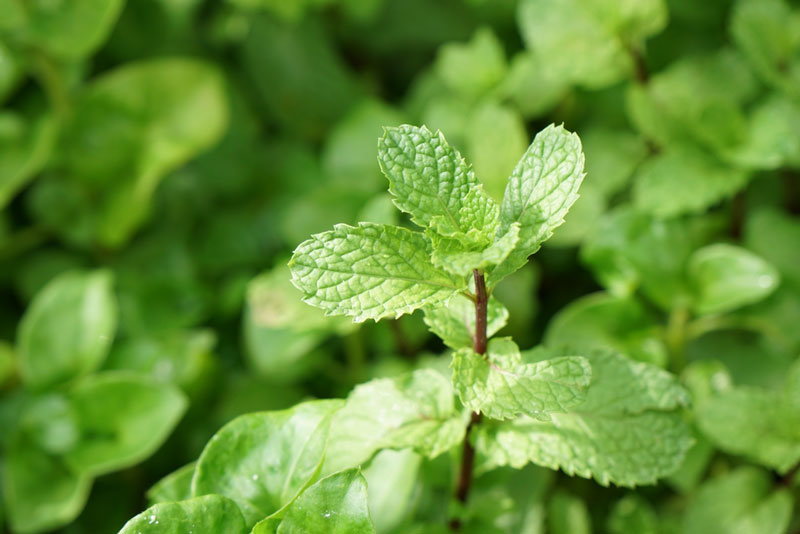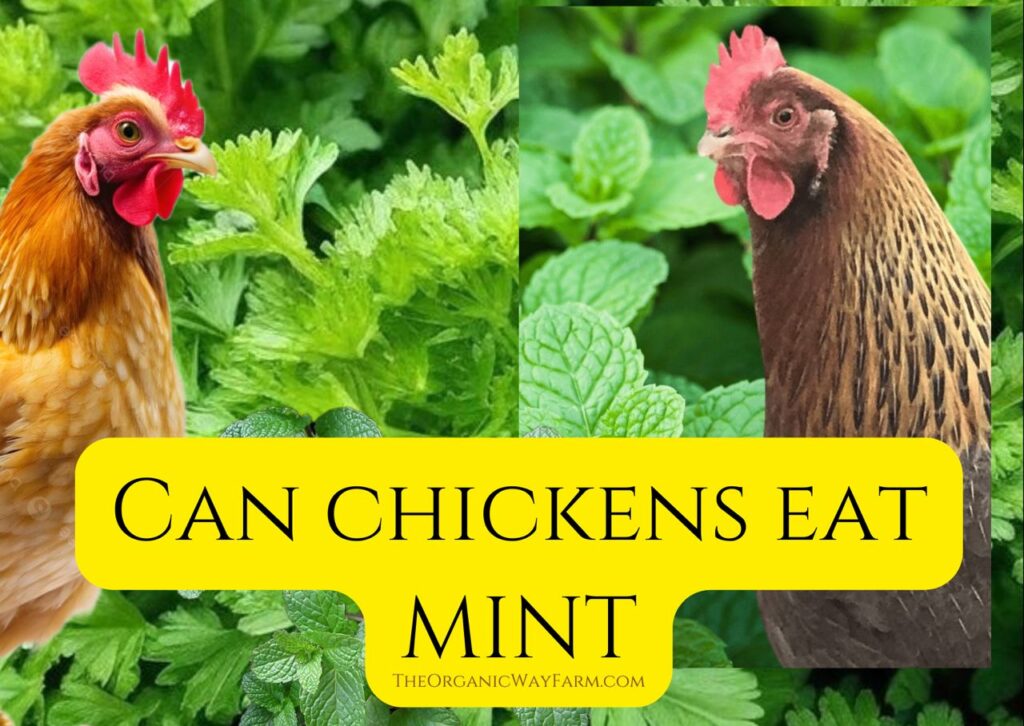If you have ever wondered about mint and its place in your chickens’ diet, you’re not alone! Many chicken keepers ponder, “Can chickens eat mint?” It’s a great question, and one that deserves a thorough answer. Mint is a delightful herb that can add flavor to our dishes, and it’s also important to know how it affects our feathered friends.
The short answer to whether chickens can eat mint is a resounding YES! Mint is not toxic to chickens, and they can eat it safely. That being said, like all things, moderation is key. So what does that mean for your chickens? What parts can they eat? How can mint benefit their health? Let’s explore this topic together!
Keep reading as we uncover everything you need to know about feeding mint to chickens, including the benefits it offers, potential risks, the best ways to serve it, and even suitable substitutes you might consider. Here’s what we will explore:
- Can Chickens Eat Mint?
- How Much Mint Can Chickens Eat?
- Best Way to Feed Mint to Chickens
- Benefits of Feeding Mint to Chickens
- Risks of Feeding Too Much Mint to Chickens
- Substitutes for Mint for Chickens
Let’s start with exploring whether chickens can eat mint!
Can Chickens Eat Mint?

Mint is a common herb used in cooking, and we often use it in teas, sauces, and even cakes. But what about our chickens? Mint is completely safe for chickens to consume. This aromatic herb belongs to the Mentha genus and has many varieties, including spearmint and peppermint, both of which are enjoyable for chickens.
Chickens have a diverse diet, and they tend to enjoy nibbling on a variety of greens, herbs, and vegetables. When introduced to mint, many chickens will eagerly peck at the leaves. Not only does it have a refreshing flavor, but it also brings a burst of aroma that chickens are naturally attracted to. Think about how nice it smells when you walk through a mint garden or open a bottle of mint extract.
It’s important to analyze what part of mint chickens can enjoy. The leaves are the most popular portion that chickens will eat, but stems can also be consumed in moderation. Remember to wash the mint leaves thoroughly to avoid any pesticide residues. Whether you grow your own mint in a garden or purchase it from the store, ensuring it’s clean, fresh, and free from any harmful chemicals is vital for keeping our flock healthy.
How Much Mint Can Chickens Eat?
When we introduce any new food into our chickens’ diet, we must consider how much they can safely eat. In the case of mint, we can be assured that they can enjoy this herb as a treat. However, too much of anything—even something as wonderful as mint—can lead to issues. The rule of thumb is to treat mint and other herbs as snacks rather than a main course.
For a small flock, a few leaves a day is a good starting point. As our chickens get used to mint, we can observe their reactions. It is common to notice some chickens getting more excited about it than others! Chickens vary in their preferences, and that’s perfectly normal. As long as they are happy and healthy, we can encourage them to explore without overdoing it.
While treating your chickens with mint, always balance their diet by ensuring they still have access to their regular feed. The majority of their nourishment should come from high-quality chicken feed, which helps maintain their overall health and well-being.
In terms of frequency, introducing mint as an occasional snack can be great. It could be offered a few times a week without fret, providing they are not consuming excessively. As we watch them enjoy the mint, we can also enjoy learning about their unique eating habits!
Best Way to Feed Mint to Chickens
Feeding mint to chickens can be done in several enjoyable ways. We could use fresh mint leaves straight from the garden or finely chop them to mix into their feed. Another option is to create treats using mint by incorporating it into homemade chicken treats that can be baked or frozen.
One popular method is to make a mint-infused water for our chickens, especially during the hot summer months. By steeping fresh mint leaves in their drinking water, we not only add a refreshing flavor but also promote hydration. Chickens love drinking flavored water, and mint can certainly make this experience much more enjoyable.
Another fun idea is to create a mint forage treat. We can take a bunch of fresh mint and hang it in their coop or run. Chickens will love pecking at it as it swings gently in the breeze. It’s an excellent way to offer mental stimulation while giving them a delicious snack!
As we introduce these new feeding methods, it’s a good time to observe our chickens. Are they excited? Are they careful or adventurous eaters? Each chicken has its personality, and that can also dictate their approach to tasting something new.
Benefits of Feeding Mint to Chickens
Hydration
One of the fantastic benefits of mint for our chickens is ensuring they remain well-hydrated. Fresh mint contains moisture and can help chickens keep their water intake on track, particularly during hot weather. When we feed them mint in various ways, we’re supporting their hydration levels, which is essential for their health.
Fiber
Mint can contribute to a healthy digestive system. Like other leafy greens and herbs, mint is a source of fiber that helps keep our chickens’ digestive tracts functioning smoothly. Regular fiber intake is crucial for proper digestion in chickens and ensures they can process their food effectively.
Vitamins and Minerals
Mint is loaded with several vitamins and minerals, including vitamins A and C, calcium, and magnesium. These nutrients support our chickens’ immune systems, helping them ward off potential illnesses. By incorporating mint into their diets, we are essentially aiding in the nourishment of our flock.
Mental Stimulation
Introducing new foods, like mint, is also great for mental stimulation. Chickens are curious creatures and love to explore their environment while searching for new treats. By offering them mint, we can keep them entertained and engaged, which promotes overall contentment in their daily activities.
Nutritional Breakdown of Mint
Understanding the nutritional benefits of mint can help guide our decisions about feeding it to our chickens. This herb contains small amounts of essential nutrients that can supplement our chickens’ regular diet when it’s given occasionally.
Risks of Feeding Too Much Mint to Chickens
While mint is generally safe for chickens, there are a few considerations to keep in mind. It is crucial not to overfeed any new treat, as too much mint can lead to digestive upset. Chickens have small digestive systems, and changes to their diet should always be introduced gradually.
Being part of the mint family, some varieties can be stronger in flavor than others. This means not all chickens will respond equally well to every type of mint. We should closely observe our chickens when offering a new type of mint and note any unusual behavior or signs of distress, such as diarrhea or lethargy.
Another risk is the potential for allergies. Although rare, some chickens may have adverse reactions to specific herbs. If we notice any changes in their behavior after introducing mint, it is wise to remove it from their diet entirely.
In addition to the risks associated with feeding too much, we also want to consider sourcing mint from safe sources. If we grow our own mint using organic methods, we can ensure it’s free from harmful chemicals. If store-bought, checking for pesticide residues is essential. We want to be responsible chicken owners and prioritize our feathered friends’ health above all.
Substitutes for Mint for Chickens
If mint doesn’t appeal to our chickens or if they happen to exhibit any adverse reactions, there are plenty of alternatives available. We can explore other herbs and greens that offer similar benefits to our chickens. Herbs such as basil, parsley, and cilantro are excellent options that provide nourishment and flavor.
Another substitute might be offering leafy greens like spinach or kale. These vegetables also contain essential vitamins and minerals our chickens need. Just like mint, they can be shredded or served whole for each chicken to enjoy. We’ve discovered that many chickens love to have a variety of foods in their diet, so switching it up can keep them fascinated with meal times!
Another exciting way to keep our chickens entertained is through forage mixes. These mixes can contain different seeds, grains, and herbs. By allowing them to scratch and search for food on their own, we keep them active and engaged.
Frequently Asked Questions
Can all chicken breeds eat mint?
Yes, all chicken breeds can eat mint. However, some may enjoy it more than others.
Is dry mint safe for chickens?
Yes, dried mint can be safe for chickens when given in moderation.
How do I know if my chickens like mint?
Observe their reactions; happy pecking and enthusiasm usually indicate they enjoy it!
Can I plant mint in my chicken run?
Yes! Planting mint can provide a great source of snacks for your flock.
What other herbs are good for chickens?
Herbs like oregano, thyme, and rosemary are also nutritious and can be offered to chickens.
Final Thoughts
Mint can be a delightful addition to our chickens’ diets. Providing them with healthy and enjoyable snacks makes their lives more fulfilling and keeps them stimulated. As we learn more about what our chickens can safely enjoy, we can make informed choices that promote their happiness and health. Remember that every chicken is unique, and experimenting with their diets, like introducing mint, can make feeding time an exciting adventure. Let’s keep exploring and ensuring our cherished flocks have everything they need to thrive!
If you want to learn about other treats, check out whether chickens can eat grapes, another delightful addition to your chickens’ diet.






